Blog & Latest Updates
Fly Fishing Articles
Insects by Common Name


Mayfly Family Baetidae (Blue-Winged Olives)
Taxonomic Navigation -?-
Kingdom
Animalia (Animals)
» Phylum
Arthropoda (Arthropods)
» Class
Insecta (Insects)
» Order
Ephemeroptera (Mayflies)
» Family Baetidae (Blue-Winged Olives)
11 genera aren't included.
Common Name
| Match | Common Name |
| Blue-Winged Olives |
"These little critters supplant the importance of many other well-known mayfly hatches."
-Fred Arbona in Mayflies, the Angler, and the Trout
Arbona did not overestimate these critters. Their great numbers and multiple broods each season make up for their size, which is rarely larger than size 16 and often smaller than size 20.
Hardly mentioned in angling literature prior to the middle of the last century, baetids have become increasingly important to anglers, rivaling any other family of mayflies in this regard. This is largely due to the extension of fishing seasons that now include the early and late periods when this familys species usually dominate hatching activity. Another important reason is the tremendous improvement in tackle allowing more practical imitation of these little mayflies. The dramatic ecological changes in many of our watersheds and the subsequent impact this has had on the makeup of taxa populations is also a factor.
Taxonomically speaking, this is a most unruly family. The entomological community seems to be perpetually reclassifying its genera and species to the chagrin of many anglers. These changes are not capricious. The reason is older nomenclatures haven't provided the taxonomic flexibility required as more becomes known about the complexities of baetid relationships. Classification of this familys genera and species is very much a work in progress. The changes have been so extensive that it is beyond the scope of this hatch page to track the taxonomic history effectively without interjecting even more confusion. If you are frustrated by the inability to find some of the old familiar names, you're not alone. Rest assured these popular hatches are listed here, just under the latest classifications. The old famous names are referenced in their hatch pages.
Common baetid hatches with a national distribution are the species Acentrella turbida, Baetis brunneicolor, and Baetis tricaudatus. In the West, Baetis bicaudatus, Diphetor hageni and Plauditus punctiventris can also be common. In the East and the Midwest, look for Baetis intercalaris and Plauditus dubius. The species Iswaeon anoka is important in both the West and Midwest. Some of the Procloeon and Anafroptilum (prev. Centroptilum) species are coming to the increasing notice of anglers across the country.
Stillwater anglers are likely to run across Callibaetis ferrugineus ferrugineus in the East and Midwest. Western anglers will find Callibaetis californicus and Callibaetis ferrugineus hageni to be very important.
Streamside identification of these mayflies to specific and often even generic level has always been difficult. This is now even more so as new taxonomic evidence has shown hind wing conformation (or lack of hind wings) and other features are less dependable as ways to tell the genera apart. Many of the lesser-known species probably produce excellent local hatches but have not caught enough attention to be properly recognized by anglers. The lesson is that we should not assume anything about the identity of many Baetidae hatches we come across; they may not even be in the Baetis genus, let alone familiar species.
Hatching Behavior
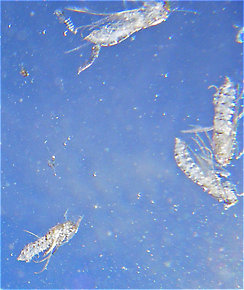
Here's an underwater view of the pupal shucks of several already-emerged Brachycentrus numerosus caddisflies.
Nymph Biology
The fast-swimming Baetidae nymphs are an important trout food even during non-hatch periods. The popular Pheasant Tail Nymph pattern, in small sizes, imitates them fairly well.
Pictures of 103 Mayfly Specimens in the Family Baetidae:
Baetis (Blue-Winged Olives) Mayfly Nymph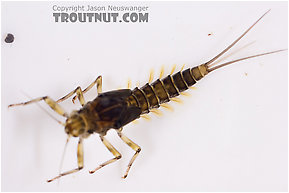 View 10 Pictures
View 10 Pictures
 View 10 Pictures
View 10 PicturesCollected May 6, 2007 from Mongaup Creek in New York
Added to Troutnut.com by Troutnut on May 18, 2007
Added to Troutnut.com by Troutnut on May 18, 2007
Male Baetis tricaudatus (Blue-Winged Olive) Mayfly Dun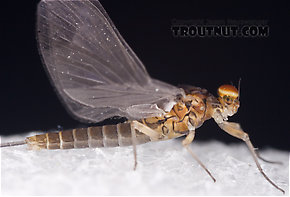 View 8 PicturesThis male was associated with a female of the same species.
View 8 PicturesThis male was associated with a female of the same species.
 View 8 PicturesThis male was associated with a female of the same species.
View 8 PicturesThis male was associated with a female of the same species.Collected April 3, 2007 from Owasco Inlet in New York
Added to Troutnut.com by Troutnut on April 3, 2007
Added to Troutnut.com by Troutnut on April 3, 2007
Male Baetidae (Blue-Winged Olives) Mayfly Nymph View 10 PicturesThis male nymph is probably in its final instar (Instar: Many invertebrates molt through dozens of progressively larger and better-developed stages as they grow. Each of these stages is known as an instar. Hard-bodied nymphs typically molt through more instars than soft-bodied larvae.). The wing pads (
View 10 PicturesThis male nymph is probably in its final instar (Instar: Many invertebrates molt through dozens of progressively larger and better-developed stages as they grow. Each of these stages is known as an instar. Hard-bodied nymphs typically molt through more instars than soft-bodied larvae.). The wing pads ( Wing pad: A protrusion from the thorax of an insect nymph which holds the developing wings. Black wing pads usually indicate that the nymph is nearly ready to emerge into an adult.) are extremely black and the large turbinate (
Wing pad: A protrusion from the thorax of an insect nymph which holds the developing wings. Black wing pads usually indicate that the nymph is nearly ready to emerge into an adult.) are extremely black and the large turbinate (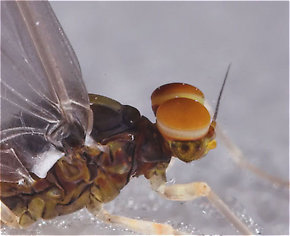 Turbinate: Shaped like a top or elevated on a stalk; usually refers to the eyes of some adult male Baetidae mayflies which are wider near the tip than at the base.) eyes are very apparent inside the nymph's head.
Turbinate: Shaped like a top or elevated on a stalk; usually refers to the eyes of some adult male Baetidae mayflies which are wider near the tip than at the base.) eyes are very apparent inside the nymph's head.
 View 10 PicturesThis male nymph is probably in its final instar (Instar: Many invertebrates molt through dozens of progressively larger and better-developed stages as they grow. Each of these stages is known as an instar. Hard-bodied nymphs typically molt through more instars than soft-bodied larvae.). The wing pads (
View 10 PicturesThis male nymph is probably in its final instar (Instar: Many invertebrates molt through dozens of progressively larger and better-developed stages as they grow. Each of these stages is known as an instar. Hard-bodied nymphs typically molt through more instars than soft-bodied larvae.). The wing pads (
The wing pads on this final instar Baetidae mayfly nymph are extremely dark.

This male Baetidae dun has slightly turbinate eyes.
Collected June 9, 2005 from the Bois Brule River in Wisconsin
Added to Troutnut.com by Troutnut on May 26, 2006
Added to Troutnut.com by Troutnut on May 26, 2006
10 Underwater Pictures of Baetidae Mayflies:
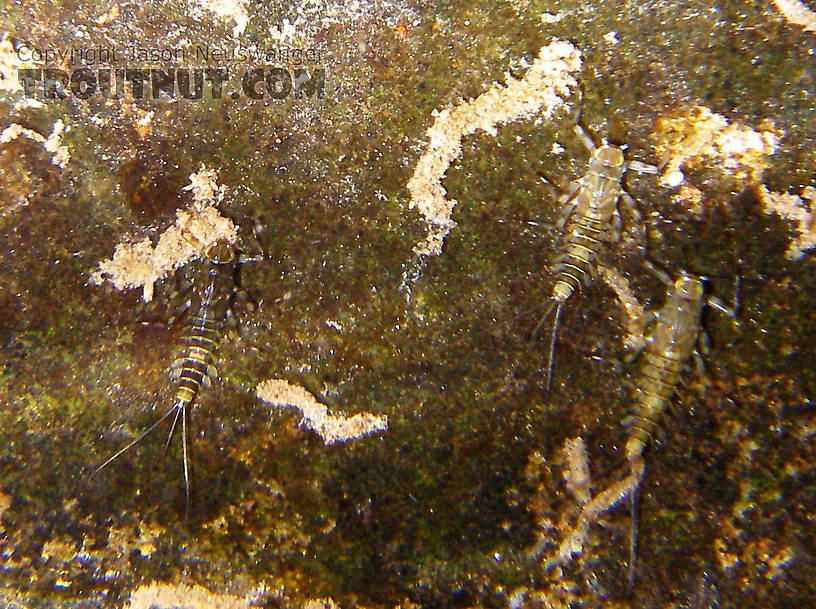
Several Baetidae nymphs line up on a rock.
In this picture: Mayfly Family Baetidae (Blue-Winged Olives).
In this picture: Mayfly Family Baetidae (Blue-Winged Olives).
StateNew York
LocationMongaup Creek
Date TakenApr 19, 2006
Date AddedApr 22, 2006
AuthorTroutnut
CameraPENTAX Optio WPi
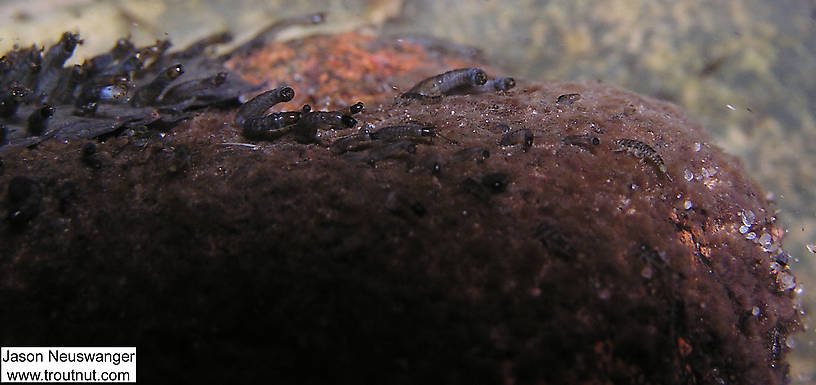
This is my favorite underwater picture so far. It shows a bunch of Simuliidae (black fly) larvae clinging to a rock and swinging in the fast current. There are also at least four visible mayfly nymphs, probably in the family Baetidae.
In this picture: True Fly Family Simuliidae (Black Flies) and Mayfly Family Baetidae (Blue-Winged Olives).
In this picture: True Fly Family Simuliidae (Black Flies) and Mayfly Family Baetidae (Blue-Winged Olives).
StateWisconsin
LocationEighteenmile Creek
Date TakenMar 19, 2004
Date AddedJan 25, 2006
AuthorTroutnut
CameraOlympus C740UZ
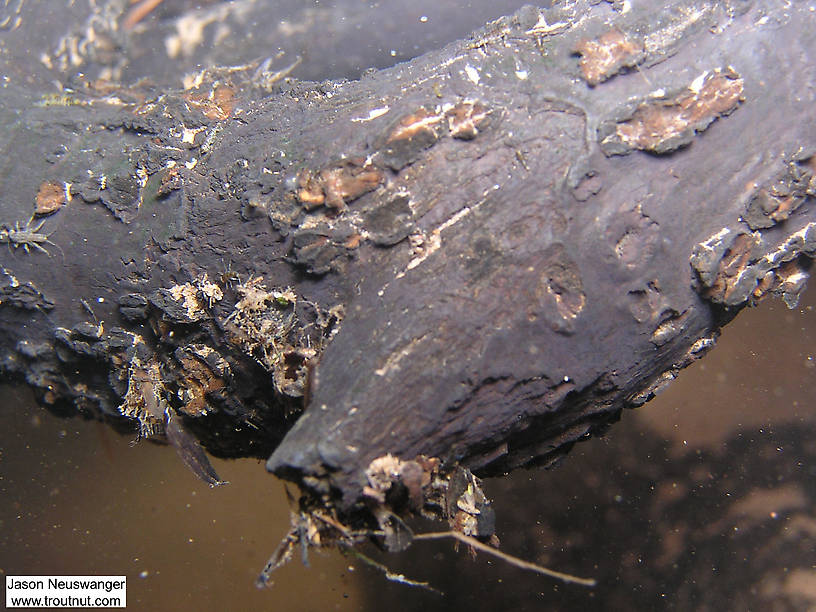
There are several mayfly and stonefly nymphs clinging to this log.
In this picture: Mayfly Family Baetidae (Blue-Winged Olives) and Stonefly Family Taeniopterygidae (Willowflies).
In this picture: Mayfly Family Baetidae (Blue-Winged Olives) and Stonefly Family Taeniopterygidae (Willowflies).
StateWisconsin
LocationEighteenmile Creek
Date TakenMar 19, 2004
Date AddedJan 25, 2006
AuthorTroutnut
CameraOlympus C740UZ
Recent Discussions of Baetidae
acentrella nymph 22 Replies »
Posted by Goose on Nov 3, 2006 in the genus Acentrella
Last reply on Sep 15, 2022 by Wiflyfisher
Hi Jason! Do you have a picture of the (acentrella-miniature BWO nymph) on the site? I've been fishing them and wanted a better idea of how they look.
Thanks,
Bruce
ReplyPossible ID 2 Replies »Thanks,
Bruce
Posted by Sreyadig on Apr 11, 2021 in the species Apobaetis futilis
Last reply on Apr 19, 2021 by Crepuscular
In searching for nymphs in my small stream in northern Maryland, 500 yards from the PA line, I came across a 2 tailed mayfly that was not a of the Epeorus genus.
It was in a fast riffle section along with Epeorus nymphs. This was about 3/8â in overall length including tails. Darker straw coloration with dark brownish black wing cases that were pronounced in color and shape. Biggest factor was the tails. Median caudal filament was truncated, very small compared to the outer pair. Not even sure if tail/ caudal filament should be used to describe. In my books the closest thing is the Pseudocloeon futile. Which is an old taxonomic name Iâm finding out.
This find seems rare in my area and experience. Hopefully I can get a photo...
ReplyMayfiles other than Callibaetis 1 Reply »It was in a fast riffle section along with Epeorus nymphs. This was about 3/8â in overall length including tails. Darker straw coloration with dark brownish black wing cases that were pronounced in color and shape. Biggest factor was the tails. Median caudal filament was truncated, very small compared to the outer pair. Not even sure if tail/ caudal filament should be used to describe. In my books the closest thing is the Pseudocloeon futile. Which is an old taxonomic name Iâm finding out.
This find seems rare in my area and experience. Hopefully I can get a photo...
Posted by Royal_Coach on Jan 15, 2018 in the genus Callibaetis
Last reply on Jan 15, 2018 by Millcreek
every book/article I read says Baetidae is the most imporant family and Callibaetis the most important genus of mayfly. Why? Does this just mean they are the most prolific? Am I not likely to encounter any other family/genus on a western river?
ReplyBig Green River, Wisconsin, late September 1 Reply »Posted by Admiralb on Sep 28, 2013 in the species Baetis brunneicolor
Last reply on Sep 30, 2013 by Entoman
I hosted two visiting delegates to the T.U. National Convention in Madison, WI. on September 25, 2013, taking them to the Big Green River in Grant County near Fennimore. There was a high overcast in the morning, and these mayflies [which I merely called "BWO's" and imitated with #16 parachute dries - thin olive bodies, gray wing posts and dun parachute hackle] - were active. Both of my guests raised browns fishing a gray nymph behind a #16 parachute dry BWO. As long as my flies catch fish, I don't need to be a detailed entomologist. Nevertheless, I do sincerely appreciate the detailed scientific info, because it helps me focus my flytying and fly selection. Thank you.
ReplyInstant Baetid Nymph Patterns 36 Replies »Posted by PaulRoberts on Feb 1, 2012
Last reply on Mar 7, 2013 by PaulRoberts
Often the first fishing for bug-eaters I do every year is the early Baetis activity. Then
the Baetid activity just continues through the year on virtually all the waters I fish. This is probably so for you all too.
I often fish a Baetid dry ahead of a Baetid nymph, since individual fish could be targeting either. I fish the #18 or #20 nymph on a short (~18-24) length of 7x to the bend of the hook of a #16 Parachute dry. A tiny daub of tungsten putty helps the short fine dropper break the surface film, as its critical to have the dropper line as straight as possible as soon as possible so I can detect every take. I use this combination all year and it's even a smart prospecting rig on waters calm enough to see the small dry.
For my bread-n-butter recipes I can be a pretty lazy tier, so I want as close to an instant tie as I can get. The following are two ~4 minute recipes:
Parafilm Baetid:
This pattern uses a single section of mallard flank barbs (tinted ahead of time with a swipe of a permanent marker) for both the tail and the legs, using the tips for the tail and the butts for the legs. Parafilm (laboratory thermo-plastic film) is used for the body, and tinted with permanent markers. The Parafilm body makes the fly sink a little quicker than dubbed ones, esp with a heavy iron (like the 3906 in this pic).
Its important to me to have the fly drift correctly in the water, not flip upside down. So it needs an ample tail to right the hook when its tethered. Also, with the Parafilm body it helps to adjust the legs with thread so they angle upwards, so they are above the central plane of the fly. I take the most time on this fly with the legs so they are equal on each side in number, length, thickness, and orientation. No need to be anatomically correct so two legs to a side is enough to suggest legs. I suspect the upside down or rolling flies affect my catch rate, as Ive had repeated refusals to such flies and then made good by tying on a fresh one.
(User-posted images are only viewable in the forum section.)
(Yeah, I know there are 4 legs on the left side -I snipped off #3 after I noticed.)
(User-posted images are only viewable in the forum section.)
Baetid #2:
The second pattern is similar to a combination of the WD40 and "Kimball's Emerger", except that it doesnt bother with the wingcase. The wingcase is suggested with permanent markers: a spot of dark brown behind the head, and two black wing-buds. Again the tinted duck flank for tail and legs, then olive thread for the abdomen, a pale pinkish-golden dubbing for the thorax. Legs equal again, but not so critical that they ride well above the central (dorsal/ventral) plane, as the dubbing adds some buoyancy. The legs should not hang below the plane or the fly will likely ride upside down.
(User-posted images are only viewable in the forum section.)
(User-posted images are only viewable in the forum section.)
(User-posted images are only viewable in the forum section.)
{EDIT}: Just noticed this fly has the wingcase, but I usually just omit it.
I tie a few others too, but these cover the dropper nymph deal pretty well for me.
What Baetid nymph patterns do you rely on?
ReplyI often fish a Baetid dry ahead of a Baetid nymph, since individual fish could be targeting either. I fish the #18 or #20 nymph on a short (~18-24) length of 7x to the bend of the hook of a #16 Parachute dry. A tiny daub of tungsten putty helps the short fine dropper break the surface film, as its critical to have the dropper line as straight as possible as soon as possible so I can detect every take. I use this combination all year and it's even a smart prospecting rig on waters calm enough to see the small dry.
For my bread-n-butter recipes I can be a pretty lazy tier, so I want as close to an instant tie as I can get. The following are two ~4 minute recipes:
Parafilm Baetid:
This pattern uses a single section of mallard flank barbs (tinted ahead of time with a swipe of a permanent marker) for both the tail and the legs, using the tips for the tail and the butts for the legs. Parafilm (laboratory thermo-plastic film) is used for the body, and tinted with permanent markers. The Parafilm body makes the fly sink a little quicker than dubbed ones, esp with a heavy iron (like the 3906 in this pic).
Its important to me to have the fly drift correctly in the water, not flip upside down. So it needs an ample tail to right the hook when its tethered. Also, with the Parafilm body it helps to adjust the legs with thread so they angle upwards, so they are above the central plane of the fly. I take the most time on this fly with the legs so they are equal on each side in number, length, thickness, and orientation. No need to be anatomically correct so two legs to a side is enough to suggest legs. I suspect the upside down or rolling flies affect my catch rate, as Ive had repeated refusals to such flies and then made good by tying on a fresh one.
(User-posted images are only viewable in the forum section.)
(Yeah, I know there are 4 legs on the left side -I snipped off #3 after I noticed.)
(User-posted images are only viewable in the forum section.)
Baetid #2:
The second pattern is similar to a combination of the WD40 and "Kimball's Emerger", except that it doesnt bother with the wingcase. The wingcase is suggested with permanent markers: a spot of dark brown behind the head, and two black wing-buds. Again the tinted duck flank for tail and legs, then olive thread for the abdomen, a pale pinkish-golden dubbing for the thorax. Legs equal again, but not so critical that they ride well above the central (dorsal/ventral) plane, as the dubbing adds some buoyancy. The legs should not hang below the plane or the fly will likely ride upside down.
(User-posted images are only viewable in the forum section.)
(User-posted images are only viewable in the forum section.)
(User-posted images are only viewable in the forum section.)
{EDIT}: Just noticed this fly has the wingcase, but I usually just omit it.
I tie a few others too, but these cover the dropper nymph deal pretty well for me.
What Baetid nymph patterns do you rely on?
There are 8 more topics.
Your Thoughts On Baetidae:
Top 10 Fly Hatches
Top Gift Shop Designs
Eat mayflies.
Top Insect Specimens
Miscellaneous Sites
Troutnut.com is copyright © 2004-2024 Jason
Neuswanger (email Jason). See my FAQ for information about use of my images.
 privacy policy
privacy policy
